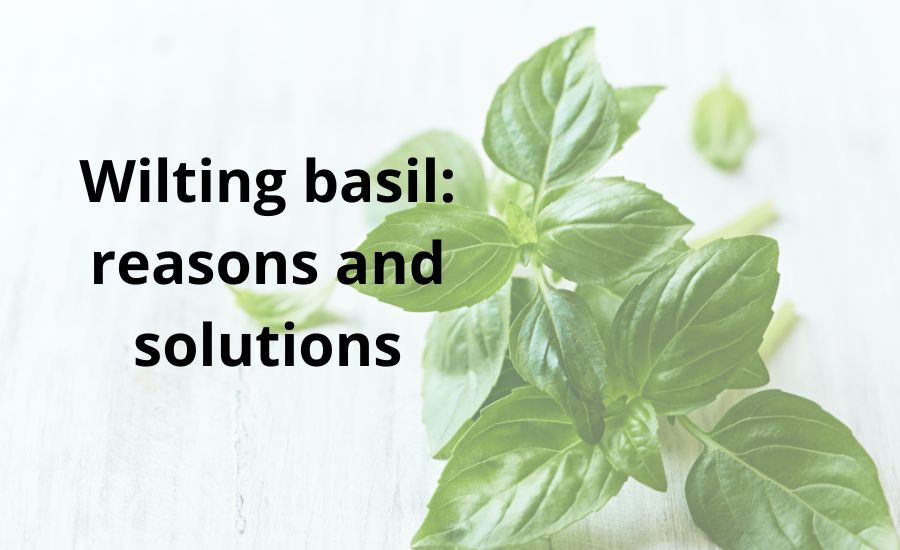Wilting basil leaves is a typical issue. Your basil leaves may be wilting for several reasons, and this article extensively discusses them with various remedies to keep the basil plant healthy.
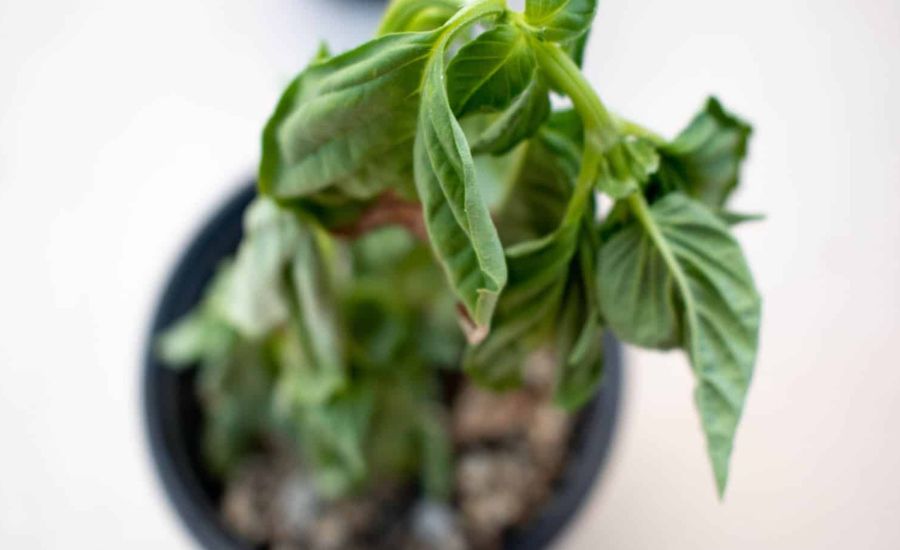
Contents
Why is my basil wilting?
In general, the Basil plant is a fairly simple herb to cultivate, yet certain things could go wrong, including mistakes you could make and diseases or pests that could cause issues.
The frequent issues individuals encounter when growing basil are listed below, along with instructions on how to spot them as soon as possible and take appropriate action to prevent them from harming your plants.
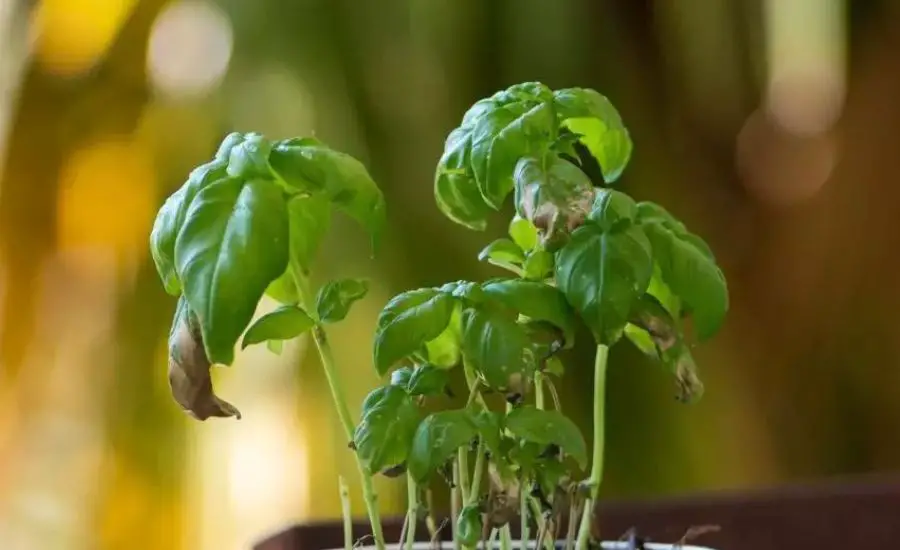
Watering issues
Insufficient or excess water might result in basil plants wilting, basil plants curling, or basil plant drooping.
Dry soil is among the most frequent reasons for basil leaves to wilt. Basil leaves inevitably wilt and fall off if submerged in water. The leaves first become yellow and then brown.
Curled basil leaves are another indication of basil plant wilting.
One more indication that your basil plant lacks water is if the soil has started to pull away from the container’s edge.
Ensure you are consistently and deeply watering your basil plant to resolve this. The soil must be damp but not drenched. If you fix the watering problem, the basil plant revives in two to three days.
If the basic leaves are still wilting even after changing your watering regimen, mulch the soil’s top layer to retain moisture and lessen evaporation.
To prevent burning the plant and to enable the earth to absorb the water, ensure to water the plant’s base rather than the leaves.
On the other hand, using an excessive amount of water might also result in basil leaves wilting. Basil leaves will first turn yellow before turning brown and wilting if they are overwatered. This is a result of the roots drowning due to a lack of oxygen. Little, yellow blooms also start to appear on the basil plant.
If you suspect that your basil plant needs more water than it is receiving, wait until the soil is fully dry before adding more water. Just water your basil plant when the soil is dry to avoid any overwatering problems. If the roots of a basil plant are submerged in wet soil, it begins to wilt since basil plants do not like to sit in moist soil.
Before watering, inspect the soil with your finger. Basil requires watering if it is dry one inch below the surface. Examine your basil pot drainage if you continue to experience overwatering issues. To assist, drain extra water from your pot, you might want to simply add a drainage layer.
Because it prefers both moist soil and direct sunlight, basil can be challenging to grow. Finding this precise balance can be tricky, but once you’ve succeeded, you’ll be able to enjoy your basil.
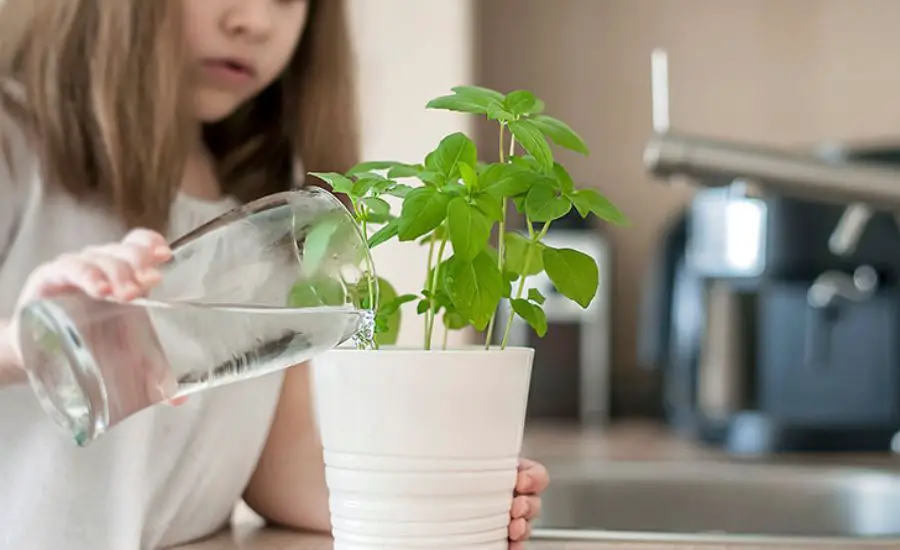
Diseases that cause basil plant wilting
Several illnesses can be the cause of basil plant wilting, including root rot, downy mildew, leaf spot, and fusarium wilt.
Root rot
As its name suggests, it is the rotting of a plant’s roots. It occurs when a plant receives excessive water for an extended period. If a plant’s root rots, it eventually dies since it will be unable to acquire water, nutrients, and stability from the soil.
Basil is quite a small and delicate plant, particularly when it is young, which makes root rot a fairly common issue.
How to spot root rot
Yellowing leaves, withering, and stunted development are the first indications that a basil plant has root rot. After some period, the basil plant starts to lose its leaves, and the soil and roots begin to smell musty.
How to deal with root rot
The plant should be moved to a big pot with fresh moist soil if it has serious root rot. If at all feasible, irrigate the plant by sprinkling water into the plate under the pot when the top of the soil is dry.
Downy mildew
Downy mildew is one disease to which Sweet basil is especially prone. Compared to sweet basil and Thai basil, purple basil plants are more disease resistant. The leaves of the basil plant may turn yellow, then brown, and eventually, wilt and fall off as a result of this disease, which flourishes in humid environments.
There is a fuzzy growth underneath the basil leaves that is gray-purple.
Take off any diseased leaves and plants from your basil if you suspect downy mildew. It is not advisable to apply fungicide on the basil plant. Basil must be eliminated if it develops downy mildew because there is no remedy for it.
Fusarium Wilt
This is a fungal disease present in garden soil that can cause basil plant wilting. A pathogenic fungus that lives in the soil is what causes this disease. The roots of plants are affected by this fungus illness, which inhibits their growth initially. They abruptly start to wilt after that.
Early symptoms of fusarium wilt include brown streaks on the stems, interior stem tissue darkening, stems that resemble shepherd’s crooks, and rapid leaf fall.
Discard any afflicted plants and leaves if you suspect your basil plant has contracted this. There is no remedy for once it has infiltrated the soil, thus the basil plant must be removed. It is advisable to start basil seedlings in fresh soil because the soil might retain the germs for years.
Buying a basil plant that is resistant to the disease, like lemon basil or purple basil kinds, is the right approach to protect basil plants from contracting it.
Leaf spot
Another disease that may contribute to the wilting of basil plants is the leaf spot. The basil plant’s leaves are attacked by a fungus or bacteria that causes this disease. The leaves eventually turn brown or black, wilt, and drop off the plant.
Detach and destroy any basil leaves with spots from your basil plant if you suspect it has it. To avoid the development of leaf spots, remember to water basil from the base.
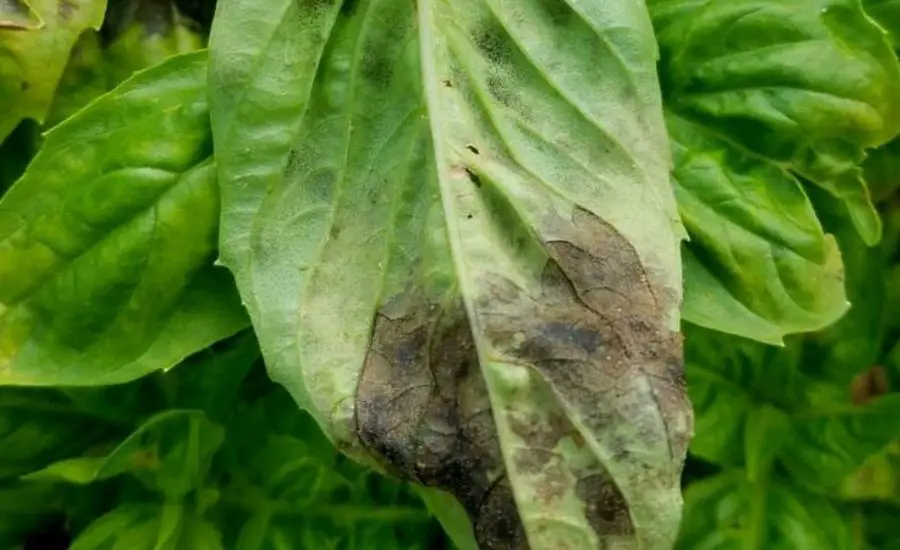
Excessively little pot
Basil plants being grown in very small pots are among the most frequent causes of wilting. Basil should be transferred to a bigger pot in the garden because the pots it comes in are frequently too small.
Basil is an herb that grows well in a variety of containers and pots (as long as they have sufficient drainage via drainage holes), but excessively small pots can rapidly dry out in the hot sun.
Basil grows best in broad daylight, but as small pots have less soil and can therefore contain less moisture, basil does not do well in them. Instead, potted basil tends to wilt because the soil dries up too quickly.
Moreover, keep in mind that plastic and metal containers conduct heat, which leads to increased soil evaporation and premature wilting of the basil. Basil can be grown effectively in small pots if the soil moisture levels are regularly monitored and watered appropriately, but the plant is always more susceptible to drought.
The easiest technique to cease basil from wilting in a pot is to grow it in a larger pot or container with a minimum diameter of 12 inches and use clay or ceramic pots rather than metal or thin plastic pots because these materials do not heat up as quickly.
When handled gently and watered as often as necessary to keep the soil moist and avert wilting, the basil plant can be moved into a larger pot.
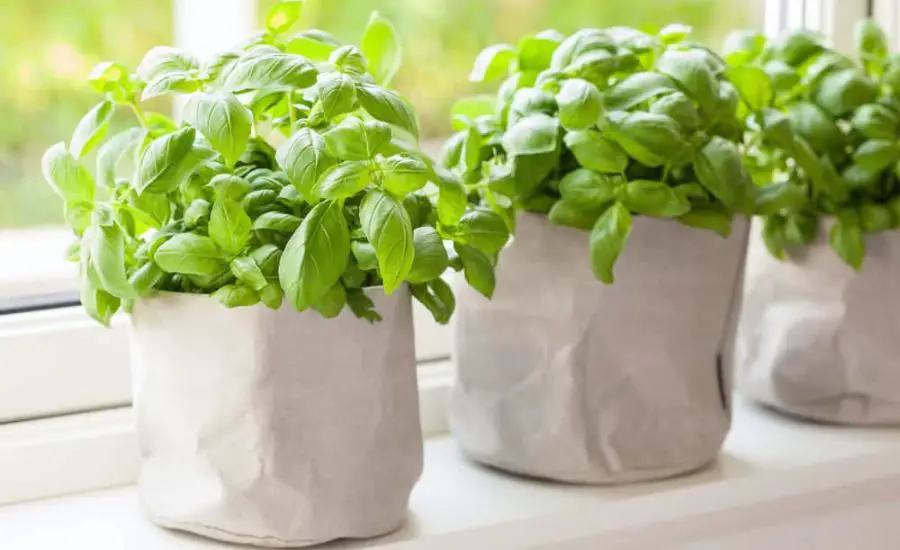
Growth cycle, pruning, and blooming
A frequent cause of a droopy basil plant is allowing the plant to bloom. Basil is mostly an annual plant that cannot resist light frost. It will blossom and generate seeds if let grow on its own, at which time it’s far less productive as regards producing fresh leaves that you can enjoy.
If the plant undergoes flowering and seeding, you’ll probably notice that the leaves wilt after blooming and that the remaining leaves aren’t as nice for cooking.
Your basil plant needs regular pruning and harvesting if you want to keep it from blossoming. Cut the plant off at the top. The leaves you remove from the plant can be used in recipes, and removing leaves from the top allows leaves lower on the plant to receive additional sunlight.
A plant that has undergone this procedure grows more leaves and is productive for a longer time frame than one that has not.
Basil plants blossom, set seed, and wilt with brown edges if they are not pruned. Most basil plants only live for a little over a year, whether you prune them or not. You can, nevertheless, increase its productive life by doing routine pruning. You can save the seeds when it sets seed so you can develop seedlings the following year.
When your basil blooms, you’ll realize that the blossoms have a delightful, fragrant scent. Basil flowers are fit for human consumption, so you may either admire them in a vase or use them in cooking.
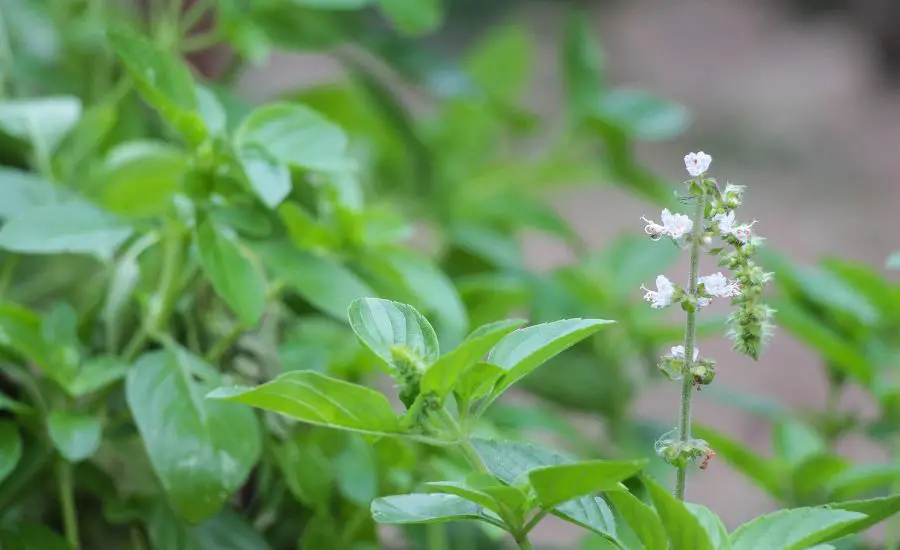
Preventative measures to stop your basil from wilting
Frequent watering
Throughout their limited growing season, you must frequently be watering basil. Don’t allow the dry soil to dry out far deeper than the surface. A productive basil plant and a wilting basil plant can be distinguished by keeping up with the right watering frequency.
Water deeply. Basil plants have a strong taproot that descends far into the pot. Provide the plant with enough water so that it reaches the tap root’s developing tip and keeps the soil cool. Potted basil demands water supply at a greater frequency.
A plant won’t benefit from shallow watering as it will promote roots to develop closer to the surface. If you see that the basil is wilting as a result of being submerged, give it a nice soak and set it in the sunlight. The roots take up water. The plant responds best to drip irrigation or surface-level watering.
Avoid immediately pouring water on the leaves because it could promote the development of mildew and other fungi.
Make sure the soil is well-draining
Keeping the soil around the roots from getting too wet is equally vital. Rich, friable soil with good water retention that doesn’t cause the clay to build up around the roots is highly recommended for growing healthy basil plants. The majority of planters purchased at a store include drainage holes on the bottom.
To prevent spills and safeguard your home, they also include a pot tray that collects the water that drains out through the drainage holes.
Too much water in the pot tray has a comparable impact as Boggy soil. Basil wilts and turns yellow in boggy soil as an indication of stress. You could irrigate the basil plant outdoors and let it drain before returning it inside to prevent this from happening.
After irrigating the plants, remove the tray from them, or put rocks deep inside the container to keep the dirt and water separate.
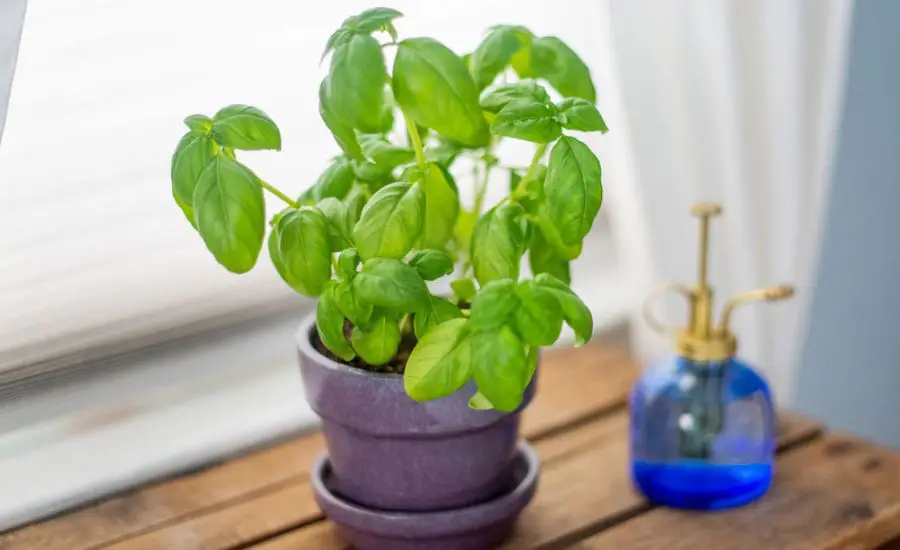
Control the soil’s temperature
The soil surrounding the pot will warm up because of the intense light and warm conditions that Basil prefers. By covering the soil’s surface with mulch, you can avoid this. This could be bark or other non-heating material. For the plant to be protected from severe temperatures, the soil around its roots must be abundant. Put your basil plant in a pot large enough to hold it.
Get rid of the growing tips
The growing tips of the plant are where the plant reproduces. Frequent removal of these will prevent the plant from flowering and instead encourage it to grow new leaves and branches, thereby extending its useful life.
Only a portion of the growth tips should be removed when you want the plant to produce seed.
By doing this, you can continue to gather leaves while still enabling plant reproduction.
Avoid parasites and other fungi
The same conditions that foster the development of fungi also support the growth of basil plants. Avoid allowing fungi a chance to establish themselves by performing the following:
For the plant to partially dry out before the air cools at dusk, irrigate it in the early hours of the day.
Irrigation at the root level will prevent water from getting on the leaves.
Water should not splash up onto the leaves if there is a layer of mulch covering them.
When the plant is damp, avoid harvesting the leaves.
Fungi feed on dead materials to survive. Immediately you notice any dead leaves, discard them.
Apply a fungicide repeatedly to the area.
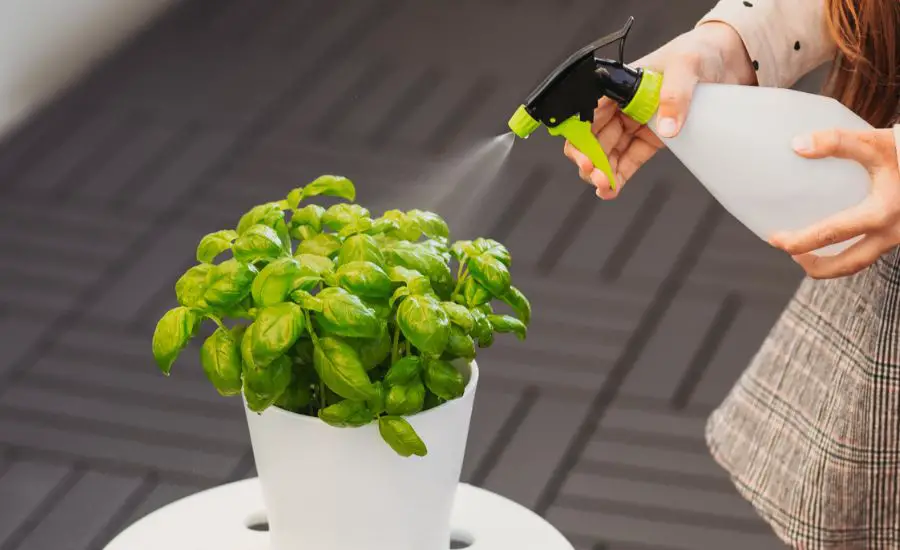
FAQ
How do you revive wilted basil?
Wilted basil can be revived by gently sprinkling it with water. You must be mindful to avoid letting the plant become overly moist and rot. Moreover, you should wait until the soil is damp before watering your basil plant to avoid having its roots rot and die.
A wilted basil plant can also be revived by placing it outside in direct sunlight for an hour and then returning the plant indoors. You must be cautious not to leave your plant outdoors in extremely humid or chilly weather so that this can work.
Replanting a wilted basil plant in new potting soil is another method for bringing it back to life.
Ensuring that the roots aren’t exposed to the air is important when doing this. When planting, ensure the soil is damp and moist. Basil undoubtedly experiences rot if the soil becomes too wet, so take care to prevent this.
To revive your basil plant, you should also water basil leaves. However, this is only necessary if you intend to use the basil leaves for at least a day or two more because wilted leaves won’t taste flavorful in your dish afterward.
What does overwatered basil look like?
Most likely, if your basil plant is wilting, it was probably overwatered. If basil plants receive either excessive or insufficient water, they typically wilt. It is likely to start decaying and the leaves start to fall off if you irrigate a basil plant that has been improperly overwatered. Wilted leaves are a sign that something is amiss with the plant.
Though less frequent than overwatering, underwatering does happen occasionally. By looking at the dirt near the base of the stems of your basil plant, you may determine if it is underwatering. Your plant may be experiencing under-watering if there is any standing water close to the stem’s base.
Is wilted basil safe to eat?
Despite having a less desirable texture than fresh, green basil leaves, wilted basil leaves are relatively safer to eat compared to brown basil. Even though your basil leaves won’t look as nice as a garnish once it starts to wilt, it’s still going to taste fantastic when used to make pesto or stew. Just be sure to cook it with as minimal heat as you can to preserve the flavor.
Conclusion
It’s common to see basil wilting. It may be caused by a variety of factors, including overwatering and excessively dry soil, among others. You must make sure that your basil plant is receiving the right care if you want to aid in its recovery and prevent the issue completely.
This includes making sure the plant receives the appropriate quantity of light, soil, and frequent watering of growing basil. If given the proper care, fresh basil leaves maintain their vibrant green color and remain healthy.

